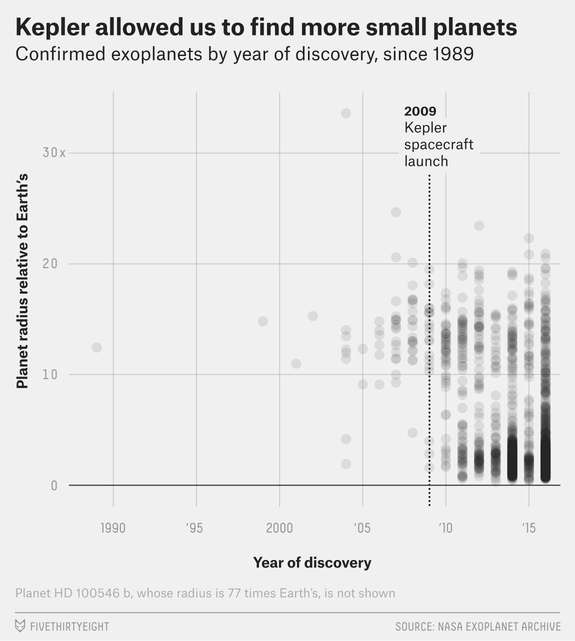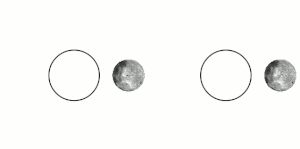
Artist Impression of the planet (from Wikipedia)
You might have heard the news a few weeks ago that astronomers had discovered a new exoplanet, Proxima Centauri b, and you should be excited about it. Given that a few months previously the space telescope Kepler announced it had discovered over a thousand new exoplanets, you might be curious as to why this particular one merits more excitement than all the others (which also merit a lot of excitement). I’m here to tell you why it does, and why it’s a damn near perfect exoplanet discovery.
An exoplanet is any planet outside of our solar system (so not orbiting our star, the Sun). Until about 25 years ago, none were known to exist. It was entirely possible that our star was the only one in the universe with any planets orbiting it. It took a long time to become confident of their existence, but now we know of the existence of thousands. We also know enough to confidently say that practically every star in the universe probably has at least one planet around it, likely more.
The logical next question is whether any of these planets are habitable, and, indeed, whether any are inhabited. There’s several problems with this line of thought, however. “Habitable” is a very loaded word, with lots of implications about the nature of planets and of life itself. The trouble is, of course, we only know of one inhabited planet in the universe: ours. All life on Earth comes from a common ancestor: LUCA, and so has a lot in common biochemically. Must life evolve the way it has here, or could it look totally different? We need to find examples of truly alien life to find out, but in the meantime our best choice is to find and explore “Earth-like” planets which can host life like ours.
Finding Earth-like exoplanets is difficult, though, even relative to the difficulties of finding exoplanets in general. The methods we use to find exoplanets are more effective the bigger the planet is, meaning that most discovered exoplanets are gas giants many times the size of Earth. Not exactly prime real estate.

Of course, so far we’ve only talked about looking at exoplanets. But if we’re ever to truly understand alien life, some day we’re going to have to actually go to one of these planets. The problem there, of course, is that space is big. Really big. Not just in the sense that it has big things in it (though that’s certainly true), but in the sense that things in it are really far apart. Travelling at the speed of light, the fastest speed physically possible, 670 million miles per hour, it takes eight minutes to go from the Earth to the Sun, a few hours to go from Earth to Pluto, and four years to reach the closest star to ours. Our fastest spacecraft go at about 38,000 mph, meaning it will take 70,000 years to travel that distance.
So if we ever want to do biological field work on an alien world, we need to find a planet that’s a) potentially habitable, and b) as close as possible.
Proxima Centauri b is both of those things.
It’s almost the luckiest break we could ask for in astrophysics. Proxima Centauri is the closest star to ours (hence the name), at only four light years away (as implied above). Hence the new exoplanet discovered around it has automatically become the closest exoplanet to Earth. So the fact that it’s “potentially habitable” is close to a goddamn miracle.
But what does “potentially habitable” mean in this context? For a start it means its mass is low — between one and three times Earth’s mass. This means it’s probably not gaseous but rocky, like Earth, and probably about the same size as the Earth. More excitingly, though, it’s at the right distance from its host star for liquid water to exist – not too hot, not too cold. (Yes, people do call this the Goldilocks Zone.) There’s not much more we know now, but it’s already ticking a lot of boxes for life as we know it to exist on its surface. Very few planets we know of tick all these boxes. This is why it’s so exciting.
It’s not all great news, however. Whilst it has some of the best odds of hosting life out of all the exoplanets we know, they’re still not good odds. It has a few things working against it. For a start, Proxima Centauri is a red dwarf, meaning it’s smaller and cooler relative to other stars (it’s still about 40,000 times the Earth’s mass). It’s actually so dim that it’s not visible to the naked eye in the night sky. (That’s why its planet was so hard to find, too.)
This means the star’s Goldilocks Zone is much closer to it (you need to stand nearer a cooler flame to feel the same heat), and indeed, our new planet friend is very close to Proxima Centauri.
This is bad because red dwarfs are known to eject violent, high energy x-rays very frequently, meaning the planet is getting big doses of radiation quite frequently. This kind of radiation means its atmosphere would get blasted away into space quite quickly, so odds are the planet doesn’t have any substantial atmosphere. (Not to mention the bad stuff that radiation is known to do to life on Earth.) Water can only exist as a liquid when the atmospheric pressure around it is sufficiently high, so the odds of a surface ocean are probably quite low.
We always see the same side of the Moon, even though it does rotate. That’s because it’s tidally locked to Earth (as we are to it). The same is probably true of Proxima Centauri and its planet: one side of the planet will always be facing the star. This can cause massive temperature differences on the different sides of the planet, meaning it probably only has water-friendly temperatures in a literal “twilight zone” in the middle of the planet.

So ok, it’s not looking great for life. But could we at least go and check? Can we ever hope to visit the planet? Well, surprisingly, despite the aforementioned vastness of space, there already is a plan to send a probe to the star within a human lifetime. Announced earlier this year, Breakthrough Starshot is an ambitious plan to accelerate microchip-sized probes to near light speed, meaning they could reach the star in a few decades, scan it, and send data back. It requires some, shall we say, “engineering innovations” (to put it very mildly) to work, but it’s theoretically plausible, and could easily be launched in a few decades. I fully believe I will see the first grainy, low-res images of this planet before I die, and given the technological challenges involved in that, it’s really, really exciting.

There’s so much more to say on this story. Exoplanetary research is a very new field. I expect this year’s physics Nobel Prize to go to something exoplanet related, and that’s only the beginning of what we’re going to discover about the distant worlds out there in the heavens. Closer to home, my supervisor and research group are involved in exoplanet research. We’re even involved in a mission to launch a small exoplanet-hunting satellite, TWINKLE, ourselves. Check it out!

Are we alone in the cosmos? It’s arguably the most profound unanswered question in science. The day we find out is getting closer all the time.